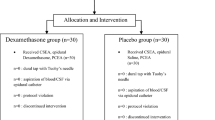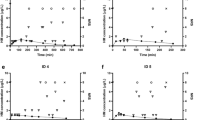Abstract
BACKGROUND: Fentanyl is an opioid drug widely used as a co-adjuvant in abdominal delivery, a fact that justifies its pharmacokinetic study under these conditions. OBJECTIVE: Our objective was to investigate the pharmacokinetics and placental transfer of fentanyl in parturients whose pregnancies were resolved by cesarian section with epidural anesthesia. PATIENTS and METHODS: Ten clinically normal parturients who delivered at term received 5 ml of 2% lidocaine hydrochloride without a vasoconstrictor for skin and subcutaneous blockade, followed by epidural injection of 2 ml fentanyl citrate (0.05 mg/ml), 15 ml 0.5% bupivacaine hydrochloride with 1:200,000 epinephrine, and 10 ml 2% lidocaine hydrochloride without a vasoconstrictor. Maternal blood samples were collected at various times after injection (1–840 min), and the fentanyl plasma concentrations were determined by gas chromatography-mass spectrometry. Pharmacokinetic analysis was performed using the bi- or tricompartmental model. The fetal/maternal ratio of the plasma fentanyl was determined at birth. RESULTS: The values of the pharmacokinetic parameters were: t½α = 13.5 min, t1/2β = 192.5 min, t1/2γ = 620 min, AUC0-∞ = 137.404 ng.min per millilter, Cl/f = 464.984 ml/min, Vd/f = 299.974 l, Cl/f/kg = 6.875 ml/min per kilogram, and Vd/f/kg = 4.441 l/kg. The latency between drug administration and birth was 28.5 min, with a maternal and fetal plasma concentration of 0.310 and 0.245 ng/ml, respectively, at a median fetal/maternal ratio of 0.892. CONCLUSION: The study demonstrated a rapid passage of fentanyl from the epidural space to maternal blood and a significant transplacental transfer of maternal fentanyl of about 90%, which should serve as an alert to obstetricians.

Similar content being viewed by others
References
Reynolds FG, Taylor C (1970) Maternal and neonatal blood concentrations of bupivacaine. A comparison with lidocaine during continuous epidural analgesia. Anesthesia 25:14–23
Gutstein HB, Akil H (2001) Opioid analgesics. In: Gilman AG, Limbird LE, Hardman JG (eds) Goodman and Gilman’s The pharmacological basis of therapeutics, 10th edn. McGraw-Hill, New York, pp 569–619
Willens JS, Myslinski NR (1993) Pharmacodynamics, pharmacokinetics, and clinical uses of fentanyl, sufentanil, and alfentanil. Heart Lung 22:239–251
Hodgksisson R, Husain S (1980) Obesity and cephalad spread of analgesia following epidural administration of bupivacaine for cesarean section. Anesth Analg 59:89–92
Justins DM, Knott C, Luthman J, Reynolds F (1983) Epidural versus intramuscular fentanyl. Analgesia and pharmacokinetics in labour. Anaesthesia 38:937–942
Little BB (1999) Pharmacokinetics during pregnancy: evidence-based maternal dose formulation. Obstet Gynecol 93:858–868
Scholz J, Steinfath M, Schulz M (1996) Clinical pharmacokinetics of alfentanil, fentanyl and sufentanil. An update. Clin Pharmacokinet 31:275–292
Tegeder I, Lotsch J, Geisslinger G (1999) Pharmacokinetics of opioids in liver disease. Clin Pharmacokinet 37:17–40
Sandler AN, Stringer D, Panos L, Badner N, Friedlander M, Koren G, Katz J, Klein J (1992) A randomized, double-blind comparison of lumbar epidural and intravenous fentanyl infusions for postthoracotomy pain relief. Analgesic, pharmacokinetic, and respiratory effects. Anesthesiology 77:626–634
Loebstein R, Lalkin A, Koren G (1997) Pharmacokinetic changes during pregnancy and their clinical relevance. Clin Pharmacokinet 33:328–343
Leveque C, Garen C, Pathier D, Mazuir E, Maneglia R, Janse-Marec J, Cousin MT (1987) Fentanyl in peridural obstetrical analgesia Evaluation after 4 years’ use. J Gynecol Obstet Biol Reprod (Paris) 16:113–121
Santos AC, O’Gorman DA, Finster M (2001) Obstetric anesthesia. In: Barash PG, Cullen BF, Stoelting RK (eds) Clinical anesthesia, 4th edn. Lippincott Williams & Wilkins, Philadelphia
Pasanen M, Pelkonen O (1990) Human placental xenobiotic and steroid biotransformations catalyzed by cytochrome P450, epoxide hydrolase, and glutathione s-transferase activities and their relationships to maternal cigarette smoking. Drug Metab Rev 21:427–446
Mathias RS, Torres MLA (2000) Analgesia e anestesia: Técnicas em obstetrícia. In: Neme B (ed) Obstetrícia básica, 2nd edn. Sarvier, São Paulo, Brasil, pp 1035
Desprats R, Dumas JC, Giroux M, Campistron G, Faure F, Teixeira MG, Grandjean H, Houin G, Pontonnier G (1991) Maternal and umbilical cord concentrations of fentanyl after epidural analgesia for cesarean section. Eur J Obstet Gynecol Reprod Biol 42(2):89–94
Author information
Authors and Affiliations
Corresponding author
Rights and permissions
About this article
Cite this article
Moisés, E.C.D., de Barros Duarte, L., de Carvalho Cavalli, R. et al. Pharmacokinetics and transplacental distribution of fentanyl in epidural anesthesia for normal pregnant women. Eur J Clin Pharmacol 61, 517–522 (2005). https://doi.org/10.1007/s00228-005-0967-9
Received:
Accepted:
Published:
Issue Date:
DOI: https://doi.org/10.1007/s00228-005-0967-9




